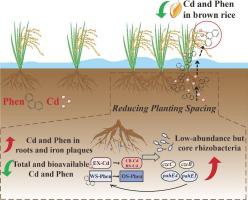当前位置:
X-MOL 学术
›
Sci. Total Environ.
›
论文详情
Our official English website, www.x-mol.net, welcomes your feedback! (Note: you will need to create a separate account there.)
Reducing the accumulation of cadmium and phenanthrene in rice by optimizing planting spacing: Role of low-abundance but core rhizobacterial communities
Science of the Total Environment ( IF 9.8 ) Pub Date : 2024-03-22 , DOI: 10.1016/j.scitotenv.2024.171856 Chen Wu , Yujun Wu , Feng Li , Xiangxi Ding , Shengwei Yi , Sicheng Hang , Fei Ge , Ming Zhang
Science of the Total Environment ( IF 9.8 ) Pub Date : 2024-03-22 , DOI: 10.1016/j.scitotenv.2024.171856 Chen Wu , Yujun Wu , Feng Li , Xiangxi Ding , Shengwei Yi , Sicheng Hang , Fei Ge , Ming Zhang

|
Optimizing planting spacing is a common agricultural practice for enhancing rice growth. However, its effect on the accumulation of cadmium (Cd) and phenanthrene (Phen) in soil-rice systems and the response mechanisms of rhizobacteria to co-contaminants remain unclear. This study found that reducing rice planting spacing to 5 cm and 10 cm significantly decreased the bioavailability of Cd (by 7.9 %–29.5 %) and Phen (by 12.9 %–47.6 %) in the rhizosphere soil by converting them into insoluble forms. The increased accumulation of Cd and Phen in roots and iron plaques (IPs) ultimately led to decreased Cd (by 32.2 %–39.9 %) and Phen (by 4.2 %–17.3 %) levels in brown rice, and also significantly affected the composition of rhizobacteria. Specifically, reducing rice planting spacing increased the abundance of low-abundance but core rhizobacteria in the rhizosphere soil and IPs, including , , , , and . These low-abundance but core rhizobacteria exhibited enhanced metabolic capacities for Cd and Phen, accompanied by increased abundances of Cd-resistance genes (e.g., and ) and Phen-degradation genes (e.g., and ) within the rhizosphere soil and IPs. Reduced planting spacing had no noticeable impact on rice biomass. These findings provide new insights into the role of low-abundance but core rhizobacterial communities in Cd and Phen uptake by rice, highlighting the potential of reduced planting spacing as an eco-friendly strategy for ensuring the safety of rice production on contaminated paddy soils.
中文翻译:

通过优化种植间距减少水稻中镉和菲的积累:低丰度但核心根际细菌群落的作用
优化种植间距是促进水稻生长的常见农业做法。然而,其对土壤-水稻系统中镉(Cd)和菲(Phen)积累的影响以及根际细菌对共污染物的响应机制仍不清楚。这项研究发现,将水稻种植间距减小到 5 厘米和 10 厘米会显着降低根际土壤中镉(7.9%–29.5%)和苯(12.9%–47.6%)的生物有效性,因为它们转化为不溶性形式。根部和铁斑 (IP) 中 Cd 和 Phen 积累的增加最终导致糙米中 Cd(下降 32.2%–39.9%)和 Phen(下降 4.2%–17.3%)水平下降,并且还显着影响了糙米的成分。根际细菌。具体而言,减少水稻种植间距增加了根际土壤和 IP 中低丰度但核心根际细菌的丰度,包括 、 、 、 和 。这些低丰度但核心的根际细菌表现出增强的 Cd 和 Phen 代谢能力,伴随着根际土壤和 IP 中 Cd 抗性基因(例如 和 )和 Phen 降解基因(例如 和 )丰度的增加。种植间距的减小对水稻生物量没有明显影响。这些发现为了解低丰度但核心根际细菌群落在水稻吸收 Cd 和 Phen 中的作用提供了新的见解,强调了减少种植间距作为确保受污染水稻土上水稻生产安全的生态友好策略的潜力。
更新日期:2024-03-22
中文翻译:

通过优化种植间距减少水稻中镉和菲的积累:低丰度但核心根际细菌群落的作用
优化种植间距是促进水稻生长的常见农业做法。然而,其对土壤-水稻系统中镉(Cd)和菲(Phen)积累的影响以及根际细菌对共污染物的响应机制仍不清楚。这项研究发现,将水稻种植间距减小到 5 厘米和 10 厘米会显着降低根际土壤中镉(7.9%–29.5%)和苯(12.9%–47.6%)的生物有效性,因为它们转化为不溶性形式。根部和铁斑 (IP) 中 Cd 和 Phen 积累的增加最终导致糙米中 Cd(下降 32.2%–39.9%)和 Phen(下降 4.2%–17.3%)水平下降,并且还显着影响了糙米的成分。根际细菌。具体而言,减少水稻种植间距增加了根际土壤和 IP 中低丰度但核心根际细菌的丰度,包括 、 、 、 和 。这些低丰度但核心的根际细菌表现出增强的 Cd 和 Phen 代谢能力,伴随着根际土壤和 IP 中 Cd 抗性基因(例如 和 )和 Phen 降解基因(例如 和 )丰度的增加。种植间距的减小对水稻生物量没有明显影响。这些发现为了解低丰度但核心根际细菌群落在水稻吸收 Cd 和 Phen 中的作用提供了新的见解,强调了减少种植间距作为确保受污染水稻土上水稻生产安全的生态友好策略的潜力。



























 京公网安备 11010802027423号
京公网安备 11010802027423号